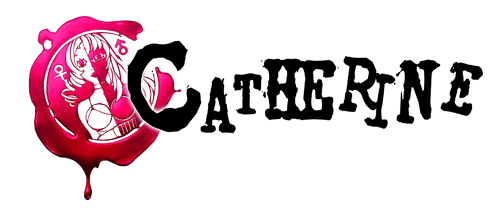The blocks are the fundamental objects in the gameplay of Catherine.
Overview[]
Blocks mainly appear in the puzzle gameplay stages where they serve mainly as platforms the player's character can stand on. Blocks can be pushed or pulled by a character in a given direction. While pushing or pulling blocks, as long as one of a block's lower edges is touching one of the upper edges of another block below, the former block will not fall down allowing the player to arrange blocks into a staircase-like formation. In adition to standing and pulling/pushing blocks, a character may also hang off a block and maneuver along the outline of edges. If a block has no supporting edge below, it will wobble briefly before falling. The player must avoid falling blocks that can crush their character, causing them to instantly die. There are many types of blocks which have additional properties unique to them; some are beneficial while others are hazardous. These principle mechanics of blocks should be followed to allow the player to complete each stage.
Block types[]
White Blocks[]
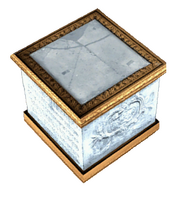
These blocks are the standard blocks which conform to all rules of blocks in Catherine with no additional features. The standard blocks in Babel stages behave like White Blocks in the game's other modes despite the blocks themselves not actually colored white.
Dark Blocks[]
Heavy Blocks[]
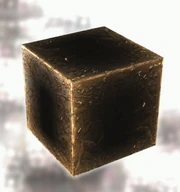
These blocks take considerably longer to move than other Block types, and are best avoided unless absolutely necessary. Note that pushing a series of blocks which includes a Heavy Block(s) take the same amount of time as moving only one.
Immovable Blocks[]

These blocks cannot be moved at all (except by gravity), and function as a border to the level or a brief respite of a pre-built staircase for the player to gain some altitude. The main visual difference between these and Heavy Blocks is the face symbol present on their front while in Babel, the former instead has the Babel logo inscribed in it while the latter are black with text displaying "100kg", suggesting the mass of the Heavy Blocks.
Cracked Blocks[]
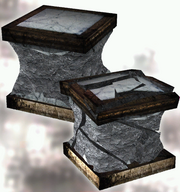
These blocks visibly crack each time any character steps on them, and will eventually crumble away completely after being stepped on enough times. There are two types of Cracked Blocks: ones that can handle being stepped on twice, and ones that will collapse after they're stepped on once. They can be distinguished by their visible damage. A character can still maneuver along the edge of a Cracked Block without expending its durability. When a character steps onto a one-step-durable Cracked Block, they can hang off of it but once the player moves while hanging, that Cracked Block will crumble away.
In Full Body, Cracked Blocks no longer have their durability deteoriate when a sheep steps on them.
Spring Blocks[]
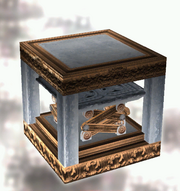
Though rare, they are the most useful block type. Falling or standing on one will propel a character upwards of a height of five blocks.
In Full Body, the Spring Blocks in Golden Playhouse and Colosseum modes now have a circle on their top surface designs to distinguish them more easily from White Blocks (whereas in the original Catherine and Catheirne Classic, the top surfaces of both the White and Spring Blocks were identical).
Trap Blocks[]

Trap Blocks deploy spikes when stepped on, instantly killing any character lingering on top of them. Any character that takes an action that is not moving off the top of the Trap Block (ie. push/pull another block or standing still on top of the block) will be killed by it when it triggers. A character dropping down from a height of two or more blocks or slipping on an Ice Block onto an active Trap Block will also be killed by it. Once deployed, the Trap Blocks are disarmed and cannot trigger again, essentially behaving as regular White Blocks.
Some actions that would cause the Trap Block to kill the character in the original Catherine and Catherine Classic can no longer do so in Full Body. These include slipping on an Ice Block onto a Trap Block (now can be avoided if the player inputs an action) and pulling a block while standing on an active Trap Block.
Ice Blocks[]

Stepping onto an Ice Block will send the character skidding forward uncontrollably until they reach a non-Ice block, a wall, a character/sheep, or the edge of the row of blocks they are standing on, resulting in death or going down one level (if a block below is attached onto its edge). However, the character can do the following without slipping on an Ice Block:
- Climb onto the Ice Block from below.
- Step down onto the Ice Block from above.
- Push and pull another block on it.
- Hang on and maneuver along its edges.
The sliding also affects other blocks and enemies.
Any movable block pushed along its surface will send that block faster, and will be placed onto its edge (toward the direction it is pushed) instead of on top of it, unless another block or character is occupying the position. It is effectively moved further; even more with a series of Ice Blocks, which slides the block onto the edge of the last Ice Block.
This principle is also applicable when pushing Ice Blocks on top of any block. This can help save precious seconds of building stairs and climbing.
Bomb Blocks[]
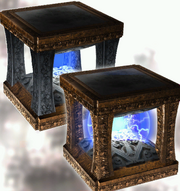
Bomb Blocks explode a few seconds after anything steps on them. This turns all nearby White and Mystery Blocks into Cracked Blocks, toggles 2-step-durability Cracked Blocks into 1-step-durability ones and destroys Cracked, Ice and other Bomb Blocks (including the triggering Bomb Block itself). The blocks have a visible fuse along the top to give an indication of how much time is left before they detonate. They also color all surrounding blocks red to show which of them will be affected. The blast radius is either one or two blocks in every direction (including diagonals) as indicated by the size and brightness of the glowing core. The Bomb Blocks' explosions do not harm the character directly. All other block types (Heavy, Immovable, Spring, Monster, Black Hole and Laser) are unaffected by the Bomb Blocks' explosions.
Black Hole Blocks[]
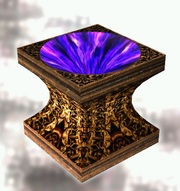
Black Hole Blocks suck in any blocks placed directly on top of them while also killing a character if they step onto them.
Monster Blocks[]

Monster Blocks can randomly move on their own in one block length of any direction, except vertically along the tower. They can only move to spots that do not cause them to fall from their current height position. They also knock any character off of them if they hang in front of their face. These blocks can be disarmed much like Trap Blocks by stepping on top of them.
Mystery Blocks[]
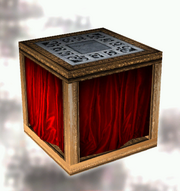
Mystery Blocks show up as curtained blocks (or question mark blocks in Babel), and transform into any other block type except for Spring (in Babel), Black Hole, Immovable, Goal, Laser and Combination Blocks when a character steps on top of them, requiring the player to proceed with caution when stepping or climbing onto them as they can become hazardous blocks (ie. Trap and Ice).
In the original Catherine and Catherine Classic, Mystery Blocks change immediately when stepped on (though sometimes they don't trigger if the character moves quickly enough) while in Full Body, they only change after the character steps away from them.
Goal Blocks[]
Per its namesake, stepping onto these blocks mark the end of stages. When the player is nearing the goal of a stage, a bell can be heard constantly ringing. Goal Blocks themselves cannot be moved (other than gravity). It is possible to cover the Goal Block with a block item, rendering the Goal Block unusable and thus making the stage impossible to finish. In Babel Pair mode, there are two Goal Blocks which both characters must stand on to complete the stage.
Laser Blocks[]
Exclusive to Full Body, these blocks periodically charge up for a short amount of time before firing a laser outwards, killing a character if they are standing or hanging in front of one while the laser is being fired. All Laser Blocks in a stage perform their functions in synchronization with each other.
Combination Blocks[]
Exclusive to Remix mode in Full Body, these colorful jewel structures of varying shapes can be used like most of the regular Blocks; they can be pulled and pushed as well as being used as platforms and support any block touching any part of the Combination Block's edges though there are specific rules to account for when the player is using them:
- If a Bomb Block explodes in the vicinity of a Combination Block, that Combination Block will turn into numerous Cracked Blocks matching their shape.
- If any part of a Combination Block moves over a Black Hole Block, that entire Combination Block will get sucked in.
The Trivia For Tonight...[]
- In Catherine: Full Body, if the player is playing on Safety difficulty, all of the hazardous blocks (Trap, Ice, Black Hole etc.) are encased inside a steel container which do not trigger their functions, effectively behaving as standard White Blocks.
| Game Information |
|---|
| Game Info · Gameplay · Puzzle Mechanics · Items · Block Types · Enemies · Difficulties · Scoring · Techniques · Undo |
